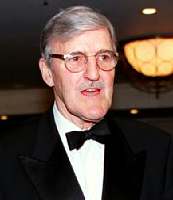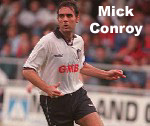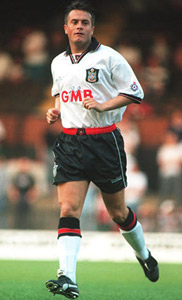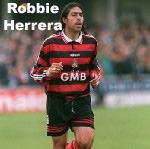 |
|

|
| Jimmy Hill |
A History Overview
Fulham is the oldest of London's first class clubs and its long history began back in 1879 with some Sunday-school boys
knocking a ball around on a long-forgotten park pitch. All a far cry from the multi-million pound internationals who make
up the Premiership team of today.
Seventeen years later, when the first game was played at Craven Cottage, the symbiotic relationship between Club and ground
was forged. More than almost any other club Fulham has become synonymous with its home, and the battle to stay there has been
a dominant feature of Club affairs on numerous occasions during Fulham's history.
Fulham's history has, at times, been a genuine Who's Who of football folklore and the roll call underpins the underachievement
of the Club through the years. England captain Johnny Haynes, one of the most gifted players of his generation, spent his
entire first class career at Fulham between 1952 and 1970. The original Maestro, Haynes made the unprecedented steps of becoming
the first footballer to earn £100 a week. However, the list does not stop there. Playing alongside Haynes in Fulham’s
last top-flight side of the 60s was another one-club man, England World Cup winner George Cohen. And to this day it can still
be claimed that England have never won the World Cup without the contribution of a Fulham player.
Fulham has long been renowned for discovering promising young talent that has progressed to win major honours elsewhere.
Alan Mullery (Tottenham & England), Rodney Marsh (QPR, Manchester City & England), and Allan Clarke (Leeds & England)
all came to prominence with Fulham. Bobby Robson has achieved success at the highest level in four countries over five decades
and it all began, for him, as a 17 year-old at Craven Cottage in 1950. More recently Ray Houghton (Liverpool, Aston Villa
& Ireland), Paul Parker (Manchester United & England) and Tony Gale (West Ham & Blackburn) all forged their careers
at Fulham before moving on to play in Championship-winning sides.
In addition to being a springboard for many blossoming futures, Fulham has been home to numerous legends in the autumn
of their footballing lives. Mullery returned to Craven Cottage in 1972 and linked up with the legendary Bobby Moore, another
of the World Cup-winning XI, to don the black and white. Together, Moore and Mullery guided Fulham through a record 11 matches
to reach the 1975 FA Cup Final. Unfortunately, Moore's former employers West Ham got the better of his new team at Wembley.
A year after the Cup final another old boy returned to join forces with a legend in his twilight years when Rodney Marsh and
George Best signed. They were both past their best, however the entertainment factor was at a premium.
Despite the FA Cup Final and the star-studded line-ups of the 70s, it is the 60s that are viewed as the sepia-tinted halcyon
days in Fulham's post-war history. The reason is pretty straight forward - between 1959 and 1968 the banks of the Thames were
home to top-flight football. This was the era of Craven Cottage crowds exceeding 30,000, the era of regular visits from the
likes of Manchester United and Arsenal. But Fulham's existence in the old First Division was often precarious. Never pushing
higher than mid-table, it was only the threat of relegation that forced Fulham to raise their game.
By May 1968 Fulham had ridden their luck once too often and the sultry 27 points on the board made relegation unavoidable.
The real reason why Fulham have never won the League Championship is that we could never work up enough speed. That's why
we've dropped back into the Second Division - to get a longer run at it, quipped Fulham's music hall Chairman of the time,
Tommy Trinder. The rabble-rousing comment may have been uttered in a light-hearted attempt to keep spirits up, but the reality
of the matter is that the run-up he spoke of took 33 years.
In stark contrast to the relative stability of life in the top flight in the 60s, the ground beneath Craven Cottage constantly
shifted as Fulham bobbed between the old Second and Third Divisions. Malcolm Macdonald's young Fulham side of the early 80s
looked to be the ray of sunshine the Club so desperately craved and were touted by many as the best Fulham team since the
60s. However, two consecutive promotions in twelve months were denied at the final hurdle as Fulham threw away their last
genuine attempt to regain top-flight status until the arrival of Mohamed Al Fayed.
As the face of football changed, so too did the disparity between the haves and the have nots, and mounting financial
pressures led to the premature break up of this side which inevitably triggered a major downward spiral in Fulhams fortunes.
In the meantime, as the Club passed between a succession of owners, all with their sights firmly set on the real estate value
of the ground, the fight to remain at Craven Cottage intensified. By this time Fulham Football Club had been at the heart
of the community for one hundred years.
As a selection of ground share options and residential developments that threatened the very survival of the Club were
tossed around, it was the mettle of an alliance of supporters, led by former Fulham player and TV pundit Jimmy Hill, who ensured
that Fulham Football Club would not be displaced from Craven Cottage.
However, as battles were fought and won in the board room, the gradual slide on the pitch continued until Fulham hit the
football basement in 1994. In January 1996 the situation hit absolute rock bottom. Home gates were averaging a meagre 4000.
The Club had less than 1000 season ticket holders, and employed only seven full time staff. In a bid to stem spiralling debt,
the team trained on Epsom Downs and, so the story goes, one infamous training drill involved circuits of a park bench! In
January 1996 Fulham travelled to Torquay United who were bottom of the entire Football League. Fulham were second from bottom,
the Club's lowest ever League position. Fulham lost. For many it was the blackest day in the entire history of the Club. Staring
non-league football right in the face, Fulham Football Club in its traditional guise was also staring at the prospect of extinction.
Such a far cry from the days of Haynes, Cohen et al.
But Fulham Football Club was too much a part of the football establishment to slip away into the abyss, and this was at
the forefront of former player Micky Adams mind when he assumed control of team affairs in 1996. Steering the ailing side
out of the danger zone, he secured Fulham's future as a Football League club before embarking on a comeback campaign the following
season. Fulham finished 1996/97 in second place in Division Three - the Club's first promotion in 15 years, achieved solely
on spirit, hard work and determination.

|
 |
|
Mick Conroy, one of Fulham' greatest, maybe!
Some of the other Fulham "Greats" from that time include:-
Simon Morgan
Micky Adams
Terry Angus
Danny Cullip
Rodney McAree
Darren Freeman
Robbie Herrera
Jim Stannard
Do you remember those?
They weren't the greatest of Fulham's players and they couldn't match the team today but they were a team and I enjoyed
watching them of a saturday afternoon.
|
|
 |
|


|
| Micky Adams |
On Saturday April 27th 2002 and after 105 years, Fulham fans watched what they thought would be the Whites last League game
at Craven Cottage in its existing guise, expecting to return to a brand new stadium built in its place on the banks of the
Thames. The drab 0-0 draw against an already relegated Leicester was reflective of the mood of the 21,106 fans present who
prepared their last goodbyes before the bulldozers moved in.
As the crowds spilled out of the ground on that spring afternoon, the uninspiring but necessary prospect of a season-long
ground share with QPR lay ahead. The reasons for the move were two-fold. Firstly the Club needed to comply with the Taylor
report that followed the Hillsborough disaster of 1989. The report declared that all First Division and Premier League clubs
must play in all-seater stadiums in order to reduce the risk of a repeat of the tragedy in Sheffield. Fulham had already played
two seasons in Division One and a further season in the Premiership at Craven Cottage a ground with two large standing terraces
at each end - and in doing so had used up their period of three years grace granted by the football licencing authorities.
Secondly, the archaic and limited facilities at Craven Cottage simply did not provide the revenue-generating capabilities
required by a club with Premiership ambitions. Not only did the stadium have insufficient capacity, it also was severely lacking
in hospitality and retail facilities. Consequently, in 1999 were plans unveiled for a brand new state-of-the-art 30-35,000
all-seater stadium to be built on the existing Craven Cottage site.
In order to have the new stadium built and open in time for the season following the year-long ground share, demolition
work was scheduled begin almost immediately after the afore-mentioned Leicester game. However due to a combination of opposition
from local residents and a series of planning-related issues, the protracted planning process for the new stadium had, by
this time, been running for three years.
The complexities of building a suitably sized stadium on a site surrounded by a park, a river and housing, not to mention
a host of environmental and aesthetic concerns, had made the entire process incredibly challenging. Nevertheless, with planning
permission granted, all was on schedule for a return to the new stadium within a year.
However, almost immediately the already tight schedule for demolition and construction ran into difficulties. Fulham Alliance,
the residents pressure group opposing the new development, launched an appeal insisting that the plans should not have been
approved by the Local Authority, suggesting instead that the proposed new stadium should have been brought in front of Government
Office of London for approval.
The additional bureaucracy undoubtedly just a stalling tactic by the Fulham Alliance made a return to the new stadium
after just a season at Loftus Road impossible, and as a consequence, the ground share became a two-year proposition.
A further series of appeals followed, and while the ultimate results of such actions went in favour of the Club, the Alliance
achieved their immediate goal of preventing work beginning. In the meantime, both the building and legal costs relating to
the new development continued to rise way beyond initial figures, with new estimates topping the £100 million mark.
Consequently, it came as no surprise when the Club announced that it was abandoning the new stadium project. Some time
after this - December 2003 to be precise - plans were unveiled for £8 million worth of major refurbishment work at the existing
Craven Cottage to bring it in line with Premiership requirements.
With planning permission granted, work began in earnest in January 2004 in order to meet the deadline of the new Premiership
season. Fulham played their first game in the new-look 22,000 all-seater stadium in a pre-season friendly against Watford
on July 10th 2004.
Speaking at a press day ahead of the official opening of the new-look Craven Cottage, Fulham CEO Jim Hone spoke about
the project and its place in the immediate future of Fulham Football Club.
A great deal of work has been undertaken since we secured planning permission to renovate the stadium at the tail end
of last year.
Everyone at the Club, from the Chairman and the Directors to Chris Coleman and the players share the fans enthusiasm that
we are returning home and I am sure you will all agree that Craven Cottage has come a long way since we last played a competitive
game here over two years ago.
The challenge is now to fill the stadium to capacity and to create the requirement for further expansion, preferably here
in Fulham. I will be disappointed if Craven Cottage in its newly expanded form is forever able to satisfy our needs as a
vibrant, progressive, developing Premiership football club. However, before we would contemplate moving out of the Cottage,
every possible opportunity to remain here as a growing business will be fully explored.


|
 |
|

And here is Johnny Haynes, one of the most well known Fulham players from the past.
John Norman Haynes (October 17, 1934 - October 18, 2005).
|
|



